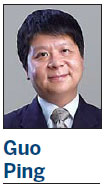Digital connections will deepen EU-China ties
Updated: 2015-06-26 06:35
By Guo Ping(China Daily Europe)
|
|||||||||||
Dialogue and collaboration are needed to tackle the challenges and opportunities of digitization
Trade between Europe and China has a history that dates back centuries to the days of the Silk Road. Today, China and the European Union are two of the world's biggest traders, and, with EU-China trade and investment having grown markedly in recent years, their commercial relationship has become a major source of wealth and development for both sides.
In an era of increasing digital connectivity, this relationship is taking on a new dimension. Digitization has transformed services over the past decade. The Internet has reshaped banking, while e-commerce has rendered yesterday's retail sector all but unrecognizable. Yet even as services continue to evolve, the focus will soon shift to manufacturing and the unprecedented changes being created by the Internet of Things.
Enabled by the data-driven manufacturing of Industry 4.0, Europe's strong industrial sector can seize its chance to assume a leadership role in tomorrow's digital economy. EU-China cooperation holds huge potential for driving this process.
Last year, European Commission President Jean-Claude Juncker released a plan to mobilize investment of 315 billion euros over three years, a move aimed at encouraging investment in broadband Internet, energy, and other economically critical areas. At the same time, Chinese policymakers embarked on an ambitious program of reforms designed to smooth the country's transition to an upper-middle-income economy while sustaining relatively high levels of growth.

Taken together, these programs highlight the wealth of win-win opportunities at hand for Europe and China.
As a global ICT leader with a strong European presence, Huawei is in a unique position to support Europe's and China's ambitious plans for their common future. Industry 4.0 will develop across three layers: devices, infrastructure, and applications.
Collaborating with Europe to drive the digitization process on each of these layers, Huawei epitomizes the win-win benefits of joining forces across geographical boundaries.
First, the continent must accelerate its efforts to make its devices smart. This means designing sensors into industrial machinery and household appliances, equipping them with operating systems and software, and connecting them to networks. This will generate enormous commercial value: A research report by BI Intelligence projects that efficiencies resulting from the Internet of Things will add $1.7 trillion to the global economy by 2019. Connected cars are one example of the IoT will touch consumers' lives.
In May, Huawei and Volkswagen announced plans to cooperate in car connectivity, unveiling technology that integrates smartphone functions with vehicle-mounted systems, allowing drivers to use those functions safely while driving.
Second, Europe must lead the development of global next-generation communications standards to create the digital infrastructure for Industry 4.0. Today, the 4G standards advocated by Europe are popular around the world. Yet as new communications connect people to things and things to each other, Europe will need to meet a surging demand for capacity and connections, many of them mobile.
Existing technologies are simply not up to the job. For that reason, Europe will begin moving toward the adoption of 5G, a standard that can support 100 billion connections, user data rates as high as 10 gigabytes per second, and an ultra-low latency of 1 millisecond.
Huawei has invested heavily in 5G, and has actively participated in the EU's 5G initiatives. We recently established the 5GVIA testbed in Munich, and in May announced the opening of a new European research institute in Leuven, Belgium. The institute will coordinate the work of Huawei's 18 research and development sites in eight European countries, and will contribute to expanding 5G and Horizon 2020 research objectives.
Third, European companies must collaborate at the application layer, where the real value of Industry 4.0 resides. They must hone their capability to create applications in automotive, energy, industrial machinery and equipment, and other verticals.
The challenges are considerable, as user demand is constantly changing. Today, for example, most drivers trust the quality of European cars, but in the future they will want to know whether innovations such as assisted driving and adjustable insurance can make them even safer.
Huawei is already making a concrete contribution to this process. The company is collaborating with applied research organization Fraunhofer to cooperate on Industry 4.0. Together with software company SAP, it aims to launch Internet of Things and Industry 4.0 solutions for the transportation, oil and gas, and manufacturing sectors.
Once applications are developed, they can be brought to market globally. Many small and medium-sized European enterprises have exceptional technology, but remain mostly local. By leveraging the right platforms and partners, they can acquire a global scale.
Over the past few years, Huawei has promoted ICT dialogue between China and Europe in areas including 5G, cloud computing, the Internet of Things and standardization, using its expertise as an innovator with a global perspective to bring joint projects to fruition.
Together, Industry 4.0 and the Internet of Things will form a huge, complex ecosystem that relies on information made available in real time through broadband networks. EU-China cooperation can make a huge contribution to making this ecosystem a reality. Realizing this potential will require unprecedented collaboration and openness, but the payoff will be worth the effort - for Europe and China.
The author is vice-chairman and rotating CEO of Huawei.
(China Daily European Weekly 06/26/2015 page9)
Today's Top News
Netizens stunned by end of Liu Xiang's 290-day marriage
Hollande urges Obama to stop espionage on allies
FM: Chinese visitors enjoy better visa policies
US Supreme Court upholds Obamacare
Greenhouse-cuts bill 'could reach 41 trillion yuan'
British queen may have to move out of Buckingham Palace
NSA eavesdropped on last three French presidents
BOC denies illegal activity in Italy
Hot Topics
Lunar probe , China growth forecasts, Emission rules get tougher, China seen through 'colored lens', International board,
Editor's Picks

|

|

|

|

|

|






